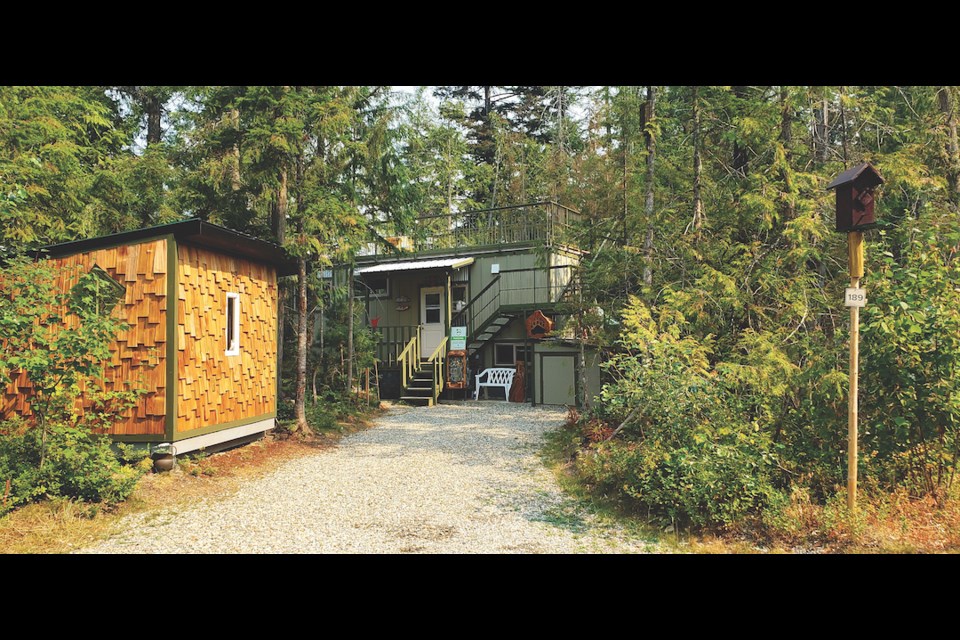Gibsons’ Buddy Boyd and Barb Hetherington have a long history with recycling and now have a zero-waste tiny home to show for it.
The former owners of Gibsons Recycling Depot passed the baton to new ownership in 2017 and have since taken on several zero-waste projects, the most recent being a 320-square-foot home on a budget.
“We wanted to show that you don’t have to be rich to do this kind of stuff – you just have to have the will,” Boyd told Coast Reporter of the approximate $150,000 build with Hummingbird Micro Homes.
Using materials gathered over decades, they added some unique features and lots of reclaimed lumber. A cast-iron wood stove was picked up by Boyd in the ‘90s and they transformed the stove pipe into a bar. (They don’t burn wood in the home.) A portion of the floor from the Commodore Ballroom – known for its “bounce” underneath dancers’ feet – was installed in their living room area. An interior light from a former Brill electric bus that ran in Vancouver from the ‘50s to ‘80s (fitted with an LED lightbulb) now serves as the main kitchen light.
The build is also efficient in its use of space. Although its footprint is 320 square feet, additional usable space was added with a roof deck (that also catches rainwater) and a raised living room brings it up to almost 600 square feet of functioning space.
“Other than that, it’s a typical tiny home,” Boyd said. Except that it’s also filled with dishware and other items either found secondhand or purchased from Wayne Harjula of Mellon Glass Studio, who makes glassware out of recycled jars.
But there have been a few bumps in the road since beginning the project in 2018. In February 2021, the couple were travelling to Malakwa (north of Vernon), where they were working on the zero-waste tiny home project, when they were caught up in a massive pile-up on the Coquihalla that claimed the lives of a man and his dog. Then, they endured three extreme heat events in the summer months and protected the tiny home project from forest fires with the help of sprinklers and water pumps. They returned to the Sunshine Coast from Malakwa on Nov. 11, ahead of the three-day atmospheric river that wiped out sections of highways in B.C.
All of these weather and environment-based events highlight some of the driving forces behind the tiny home: sustainability and resource efficiency.
“It’s been a pretty extraordinary year,” Boyd said. “And we haven’t given up hope.”
All of the windows are triple glazed, there’s thick insulation and air exchangers. Water efficiency was another goal of the project. A waterless urinal and toilet with built-in sink save space and resource use in the bathroom. A drawer with a built-in refrigerator is more energy efficient and they have a composting set up built into the kitchen counter as well. The project is also outfitted with an electric vehicle charging station, which keeps the price of their trip between Malakwa and the Sunshine Coast to about $30 for the nearly 600-kilometre trek.
“It’s really about raising awareness of us being less wasteful, living more efficiently, and lowering our footprint,” Boyd said.
The couple sits on the board of Zero Waste Canada and Hetherington is a board member of Zero Waste International Alliance. After their 16-year tenure with the Gibsons Recycling Depot, they undertook a cross-country roadtrip in an electric vehicle they dubbed the Bolt Across Canada.
It was during that endeavour the couple came across the location where they would eventually build their tiny home, an RV park in Malakwa. For Hetherington, the position next to a provincial park was an important part of the project and zero-waste initiative.
“An important part of zero waste is tuning in and learning from nature and ... how to live with nature,” she said.
“We’ve never built a tiny home before and we never drove an electric car across Canada before. We never built a recycling depot before. But we’re big fans, especially when we attach the zero-waste component to it, of proof of concept,” Boyd said.
“We’ve always been big fans of ‘Put your money where your mouth is,’ and the proof of concept seems so much easier to demonstrate to people what you could actually do right now versus ‘This would be a good idea to try someday.’”
They hope to inspire people to rethink affordable housing and sustainability and will be doing tours for people interested in trying out tiny home living. Eventually, they’d like to add solar power and a battery bank to go off-grid.
“That might be a year or two away, but you’ve got to still have goals,” Boyd said.
As for their next chapter, the couple will be helping Hummingbird Micro Homes design their tiny home villages to be more sustainable.
– With files from Sophie Woodrooffe, Coast Reporter



